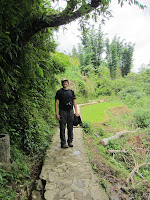When you're on vacation, you usually schedule your transportation logistics beforehand...
When you're travelling, you get unceremoniously ushered off a bus half-awake at 6 in the morning and left to find a pick-up truck to take you to the village that is your intended destination.
When you're on vacation, a layover usually means two hours spent at an airport...
When you're travelling a layover is walking 3 KMs with all your gear to find a hostel to sleep at for 5 hours before taking the early bus out of town.
When you're on vacation, you take the extra few hours in the morning to sleep in because, gosh darnit, you've earned it...
When you're travelling, you set the alarm for 4:45 to catch sunrise over the mountain/beach/valley/etc. where you are staying.
When you're on vacation, you are taking a little bit of time off from the "real world"...
When you're travelling, you have a hard time convincing yourself that what you're currently doing should not in fact be your constant reality.
With that in mind, let's recap our (little less than) week visiting the village of Champasak, the 4,000 islands of the Mekong River, and the Kang Lo cave.
We took a night bus from Vientiane to Pakse, the transport hub to the southernmost travel locations in Laos and then the pick-up to Champasak village. What brought us to Champasak was
Vat Phou - an old Khmer temple ruin site that may have been the blueprint for Angkor Wat. We rented a pair of bicycles from our guesthouse to ride over to the temple site. The temple grounds, though nowhere as grand or preserved as Angkor Wat, did make for an interesting visit as we were able to identify some architectural and design similarities between
Vat Phou and the Khmer temples in Siem Reap and because climbing up to the upper terrace of the site gave us great views of the villages below. Unfortunately, on the ride back, Avi's back tire popped out of alignment and so we were forced to ride 2-person on our remaining functional bike.
 |
| The Grassy Walkway Up To the Vat Phou Ruins |

The Vat Phou Temple Ruins
 |
| Walking Up To the Top Terrace |
 |
| The Shrine At the Top |
 |
| The View From the Top Terrace |
 |
No Man Left Behind - Rach Rode On the Back Cushion
While Avi Labored to Get Us Back To the Guesthouse |
After our day in Champasak, we rode town to Si Phan Don (meaning 4,000 islands), the archipelago of islands at the southern tip of Laos's stretch of the Mekong River. We stayed on Don Det, the most developed island of the 4,000. We spent our time relaxing, riding bikes, spotting fresh-water irrawaddy dolphins, and re-immersing ourselves in American culture by watching movies at one of the bar/restaurants.
Here are a few shots of local life on Don Det:
 |
| Rice Fields On Don Det |
 |
| Haggling Over Goods |
 |
| Playing Soccer/Volleyball |
 |
| Local Kids Plowing the Fields |
 |
| And One Kid Who Got the Night Off |
 |
This Man Gave Us An Impromptu Fortune Telling Based
On Our Birth Years |
 |
| Some Foliage |
And here is some of the fun we had:
 |
| Sunset On Don Det |
 |
| On the Boat Searching For Dolphins |
 |
| A Dolphin Siting - We Saw Better Than We Photographed |
 |
Here's What the Irrawaddy Dolphins Actually Look Like
(Photo Taken From the Net) |
 |
| Oh Yeah - Cribbage At the Bar! |
 |
| And the Most Epic Game of Jenga Ever |
After 2+ days on Don Det, we took the 11 AM ferry shuttle back to Pakse and then a bus to Thakhek, the nearest city to the Kong Lo cave. We got to Thakhek around midnight and to our guesthouse about an hour and a half later (see above) and caught a few short hours of sleep prior to taking a minivan out to the cave around 7:30 AM. We got to the cave around noon and spent about 3 hours there. We then took a minivan to a bus back to Vientiane, arriving there around 10 PM - just in time to grab dinner and find another crash pad for the night. So during the 37 hours from when we left the islands to when we got to sleep in Vientiane (almost midnight the next day) we logged about 24 hours of transport, 10 or so hours of sleeping, 3 hours touring, and one delicious meal back at the Indian restaurant in Vientiane... we are definitely NOT on vacation.
Now as for the cave itself, it was phenomenal!
Tham Kong Lo (Kong Lo cave) is a 7.5 KM tunnel through a limestone mountain. The motorboat ride through the cave and back, including a walk through some trippily-lit stalactite and stalagmite formations, takes around 3 hours. You spend most of that time in absolute darkness, save for the beams of light emitted from your and your boat-mates' flashlights. The cave's roof reaches cathedralesque heights in some of the chambers and the thought of wading through these large halls that are bearing the weight of the entire mountain is both terrifying and thrilling. It was also really dark, which is why we took only a few pictures:
 |
| Hanging In the Cave |

And the Kooky Lights Inside













































































